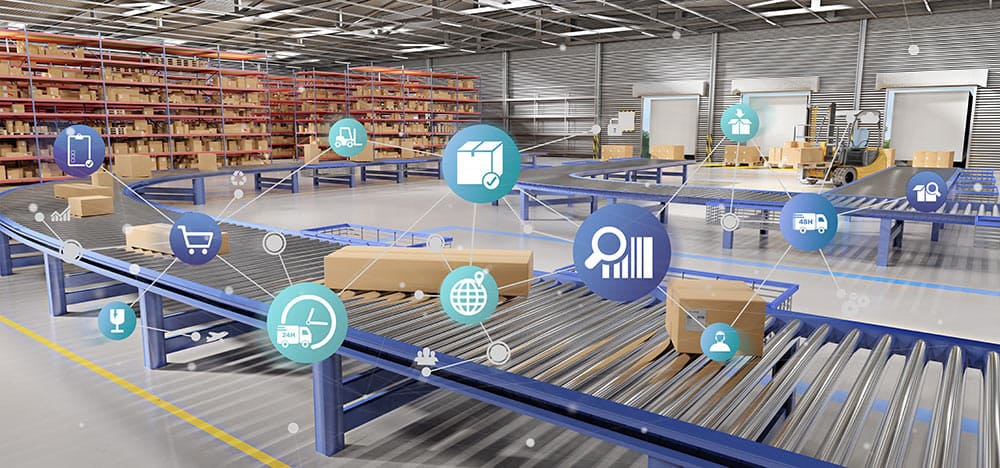The words “warehousing” and “logistics” are often used together, so it isn’t surprising that some people confuse the two or believe they mean the same thing. In fact, they are two separate but interconnected business functions.
Logistics is the overall process of managing how goods, services, and information are acquired, stored, and transported to their final destination. Warehousing is the storage of goods or raw materials in a commercial building. So, warehouse logistics refers to the management of goods as they flow into, are stored in, and move out of a warehouse.
What is the function of a warehouse in logistics?
Simply put, a warehouse offers safe, secure, and organized storage of goods. It gives a business better control over inventory by providing a centralized location for its products.
Since all goods are received, stored, and distributed from one place, transportation costs are reduced and other operations, such as order consolidation, assembling, mixing, and cross-docking of products, become more efficient. More efficient operations lead to improved customer service and increased revenue.
What are the types of warehouses?
There are different types of warehouses, which perform a variety of functions and services. Choosing the right one can be crucial to a company’s success. Here’s a brief look at the most common types of warehouses:
Private Warehouses
Private warehouses are owned and operated by wholesalers, distributors, or manufacturers. Large retail or online marketplaces, farmers, and trade organizations may also have privately-owned warehouses.
Public Warehouses
Public warehouses are third-party businesses and leased to other companies for storage and distribution. While many small business owners can’t afford to own or lease a private warehouse, a public warehouse offers short- or long-term storage and bases its fee on the amount of space required and the services provided.
Automated Warehouses
Automated warehouses (also called smart warehouses) rely on the most modern technology in their storage and fulfillment processes. Everything is automated to increase production, decrease errors, and reduce the manpower needed to run the warehouse.
Climate-controlled Warehouses
As the name implies, climate-controlled warehouses are used to store goods that require special handling. Cold storage is a type of climate-controlled warehouse which allows items such as medicine, perishable food, flowers, etc. to have a longer shelf life. Another type of climate-controlled warehouse offers a dust-free environment for sensitive computer components.
Bonded Warehouses
Sometimes called customs warehouses, bonded warehouses are owned and operated by the government or government-licensed private agencies and are used to store imported goods. Goods may be stored duty-free for up to five years, giving importers time to find their customers.
Distribution Centers
Distribution centers, which are typically bigger than other warehouses, are designed to move large quantities of goods in a short amount of time. Goods are received from multiple suppliers and then shipped out to resellers and retailers.
Because they must move items quickly and efficiently, these warehouses are often located near transportation centers. Most distribution centers also use computer software to manage warehouse logistics.
What are the challenges of warehouse logistics?
A warehouse is a huge building full of inventory, and, without efficient organization, it can be a liability rather than an asset. Inventory management is the biggest challenge to warehouse logistics because a company must know exactly how much product it has in stock as well as where to find each particular item. Adjacent challenges include warehouse organization and security, employee communication and productivity, cost controls, and risk management.
What is a warehouse management system?
A warehouse management system (WMS) is a software application that allows a company to track each item down to the minutest level of detail from the moment it enters the warehouse. Because warehouse logistics depends on inventory management, a WMS is crucial in tracking which items are in stock, where they are stored, and which ones need to be shipped. Every item in the warehouse is accounted for in real-time, at all times.
Employees are able to work more efficiently since they have comprehensive activity logs which detail each step of the order process. Using a WMS reduces errors in order fulfillment and enhances customer service. Additionally, with its real-time recording and tracking of data, a WMS can help a company comply with government regulations and support risk management.
How can Nexterus help?
With more than 75 years of experience, Nexterus is a leader in the logistics and supply chain management industry. We have a team of experts who can help you navigate the challenges associated with warehouse logistics.
Contact us today to talk about how we can help your company move further along the road to success.



